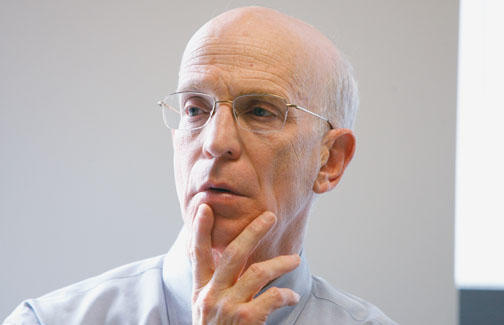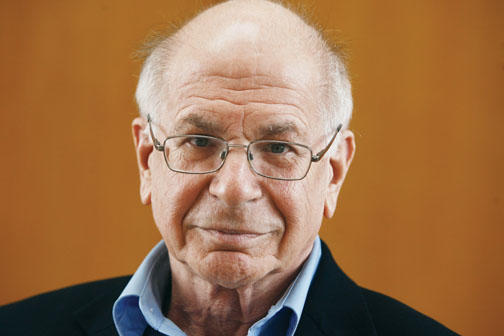
For a summary of the bleak economic forecast, look no farther than the Princeton economics faculty: The United States, writes Paul Krugman, “may well be falling into an economic abyss” that officials in Washington continue to underestimate (The New York Times, Feb. 5). Alan Krueger, examining recent job losses, sees “no silver lining” in the labor market — education, health care, and government are the only sectors holding their ground (The Los Angeles Times, Jan. 10). And when Alan Blinder ’67 imagines an economic-policy genie that could grant three wishes, he acknowledges that his suggestions to the genie amount to an incomplete solution — no policymaker could restore Blinder’s portfolio “to its former glory” (The Wall Street Journal, Feb. 4).
Yes, times are hard, but economists are not just evaluating the economic meltdown — they’re looking for solutions, learning lessons, and sharing insights with students and policymakers. PAW spoke with four Princeton faculty members to learn more about America’s economic outlook, examining topics that range from bubbles to behavior.
HARRISON HONG
Harrison Hong, the John H. Scully ’66 Professor in Finance, has a voice that carries some weight, on campus and beyond. An expert on financial bubbles, he is part of what a May 2008 Wall Street Journal story dubbed Ben Bernanke’s “bubble laboratory” — a group of researchers whose work has aided the Federal Reserve chairman’s understanding of market dynamics since the days when he served as chairman of Princeton’s economics department. (Princeton professors José Scheinkman, Markus Brunnermeier, and Wei Xiong also were highlighted in the Journal story.)
Bubbles often grow in financial markets, typically when investors are excited about innovations and cannot agree on the price of assets. Economists have several explanations for why assets tend to become overvalued in this scenario. For instance, investors might simply overreact to exciting news, the risks and costs of short selling (betting on stock prices to go down) could reduce the influence of pessimistic investors, or stock analysts could be biased toward positive forecasts. Optimistic investment advisers also may play a role in the upward bias, according to a model that Hong, Scheinkman, and Xiong published in the Journal of Financial Economics last August.
Despite the inevitable burst, Hong insists that bubbles are not always bad. Think of the tech boom of the 1990s and early 2000s: Though many people lost money as overvalued stocks tumbled toward zero, the recession was relatively mild, and the excitement that surrounded the Internet bubble brought young, innovative minds into that sector of the economy.
But when a bubble bursts in the housing market, the destruction can reach across the entire economy. Housing is linked naturally with banks through home mortgages, and in the current case, the U.S. housing bubble also wreaked havoc on investment banks, which held packaged mortgage debt. Hong says that while many economists predicted a collapse of the housing bubble, few expected investment banks to be caught so deeply in the crisis.
What does the United States’ predicament look like? The most frequent comparison is to Japan in the 1990s, when the Japanese experienced a stock-market crash and real-estate plunge followed by a prolonged economic slump that became known as the country’s “lost decade.” “The parallels are pretty eerie,” Hong says. Fearing unemployment, the Japanese propped up troubled banks with injections of government cash, creating “zombies” — banks that provided little value as lenders but drained public coffers and restrained hopes for a nationwide recovery.
Many economists believe the United States could end up in a similar predicament, but Hong points out important differences between the United States and Japan. Japanese companies tend to be more loyal to CEOs, even when they are overseeing stagnant or declining enterprises, while in American corporations, changes at the top are more fluid, with new leaders installing more successful strategies (at least, that’s the hope). Americans also seem to have more tolerance for inflation than Japan’s citizens have. These factors and others could help to position the American economy for a rebound, according to Hong.
“One has to keep a little bit of perspective that yes, things are bad, but the United States has a pretty remarkable economy,” he says. “It’s been a very flexible, entrepreneurial, innovative economy. ... I’m a big believer in that.”
JAKUB JUREK
The first class that Jakub Jurek taught at Princeton, “Fixed Income: Models and Applications,” started Sept. 15, the day that Lehman Brothers went bankrupt. The news cast a pall on his students, many of whom were upperclassmen with Wall Street aspirations. After finishing his lecture, Jurek sent an e-mail to his mentor at Harvard, John Y. Campbell, who had taught at Princeton on Black Monday in 1987, when the stock market dropped by 22.6 percent — still the biggest one-day loss ever in percentage terms. Campbell replied with a succinct assessment: “It’s an ill wind that blows nobody any good!”
Jurek, an assistant professor of economics, was well acquainted with one of the primary drivers of that “ill wind”: structured finance. At Harvard, he had worked with professors Joshua Coval and Erik Stafford on research of collateralized debt obligations, or CDOs. The specific examples that Jurek studied were backed by investment-grade corporate bonds, but many other CDOs used home mortgages as the underlying assets.
Structured finance relies on pooling assets and then “tranching” them — dividing the pool into a series of prioritized claims. If assets default, the most junior tranches (the word means “slice” in French) absorb losses first, followed by the midlevel or mezzanine tranches, and finally, the senior tranches. A senior tranche is a relatively safe investment, as long as the pooled assets are not likely to default all at once.
When Jurek and his colleagues began studying CDOs, the market for structured finance and derivatives had been growing at an astonishing rate, with U.S. issuances increasing 10-fold in a decade. That meant one of two things: The products were filling an enormous unmet need in the market, or arbitrage was at work (that is, issuers were profiting from the naïveté of the investors). Jurek leaned toward the latter explanation.
The team’s findings, first posted in a July 2007 online working paper, concluded that “many structured-finance instruments can be characterized as economic catastrophe bonds” — bonds that default only during a severe economic downturn. But that is exactly when money is most valuable. Given this ill-timed risk, investors should have demanded a higher yield, but instead they trusted ratings agencies that viewed structured-finance products as safer than they actually were.
Investment banks profited from their role as originators of structured-finance products — in particular, products backed by home mortgages — but it was not a simple case of arbitrage. If the banks had fully understood the risks of structured finance, Jurek says, they would have been motivated to issue and sell the products they were creating without investing themselves. Instead, they kept large portions of the investments on their own balance sheets.
An unmet need for highly rated assets influenced the market, Jurek says. Banks and certain investors, such as pension plans, need “investment-grade” securities (rated BBB- or higher) to meet capital or investment requirements, and the natural supply of such securities is relatively small. But Jurek says that the ratings agencies failed to notice distinct mathematical differences between the risks associated with structured-finance products and those associated with regular bonds. He and his research colleagues found that pooling and tranching amplify seemingly minor mistakes in one’s assessment of the default risk for a CDO’s underlying assets. The experiments they used to deduce these problems were not unreasonably complex; calculations were run on a normal desktop computer. “I find it difficult to believe that people at the credit-rating agencies wouldn’t have done those types of experiments,” Jurek says. “If they didn’t, it’s a critical failure of their imagination.”
While Jurek acknowledges the flaws of structured finance, he is not ready to bury the category. Structured finance will continue to play a role in the risk-sharing function that banks provide, but investors will need to be more vigilant when scrutinizing new products, he says. Smarter investing starts with fairly simple economic concepts, like the ones on a checklist of questions Jurek gives to students in his fixed-income course: How is the investment constructed? What are the underlying risks? In which economic states will this asset pay off? In which economic states will it fail?
“With any financial instrument,” Jurek says, “unless you fully understand it, you shouldn’t be participating.”
ALAN BLINDER ’67
Wall Street veterans have an old saw: We can make money under any rules, as long as we know what the rules are. The second half of that maxim fell through the floor in September when federal regulators allowed Lehman Brothers to fail. Gone were the ideas that large investment banks were “too big to fail” and “too entangled to fail,” invoked six months earlier when the Federal Reserve made an emergency loan to Bear Stearns.
“It destroyed the notion that there was a rule book governing what was going on,” says Alan Blinder ’67, the Gordon S. Rentschler Memorial Professor of Economics and Public Affairs.
Letting Lehman Brothers fail was a mistake, Blinder says, and it was one of many failures of leadership during the financial crisis. For most of 2008, the spokesmen for the American economy were a disengaged president, George W. Bush, and a passive treasury secretary, Henry Paulson — unconvincing voices, in Blinder’s view.
“Don’t get me wrong — a speech was not going to set things right,” he says. “A lot had to be done.” But with few explanations coming from the White House, he adds, taxpayers were left with no understanding of what caused the financial mess, a vague plan for getting out of it, and, consequently, little confidence that the plan would work.
The plan itself — the Troubled Assets Relief Plan, or TARP — was much maligned in its first phase when the U.S. Treasury, under Paulson’s direction, distributed $350 billion to banks with no strings attached. Blinder believes that taxpayers deserve some quid pro quo — assurances that the money would increase lending or mitigate foreclosures, for instance — but he also notes that the TARP money is just a fraction of the government money being used to treat the ailing economy.
“Crazy as it sounds, $700 billion [the value of the TARP] is a minority of the money that’s at stake,” Blinder said in late January, before the Obama-backed stimulus package was passed. “The Federal Reserve has blown up its balance sheet by between $1.5 and $2 trillion — something between double and three times the size of the TARP.”
Blinder, a former vice chairman of the Federal Reserve Board, says that allowing such expansive spending by the Fed, an organization run by technocrats appointed by the executive branch, poses philosophical problems in a democracy. Elected officials, he notes, are supposed to be the ones who appropriate taxpayer money.
When evaluating the Fed’s actions strictly on efficacy, Blinder cautiously gives them high marks. The Fed, he explains, has abandoned the “company-by-company fire-brigade” approach and moved instead to a market-by-market strategy. For example, in October, the Fed began buying commercial paper — short-term, low-cost loans issued by and for corporations to meet everyday needs such as payroll. When the Fed entered the market, it was virtually the only buyer, but its presence has helped to set prices and gradually return a sense of normalcy.
“The idea here is that you start creating some activity in some of these markets by actually having a buyer present,” Blinder says. “That establishes prices and starts to restore the market. And then you ease yourself out of it — let the market work the way it used to work. ... It’s the government getting in and performing functions — in this case lending functions — that private lenders are supposed to perform.”
The Fed is using the same approach to set prices for asset-backed securities funded by credit-card receivables, automobile loans, student loans, and small-business loans through its Term Asset-Backed Securities Loan Facility (TALF).
Critics say the actions are tantamount to socialism, and a year ago, Blinder admits, few would have advocated such extreme measures. But a lot has changed in one year.
DANIEL KAHNEMAN
For psychologist Daniel Kahneman, who won the Nobel Prize in 2002 for his pioneering insights into behavioral economics, there are few surprises in the way people have reacted to the current economic crisis. A pervading sense of insecurity is a natural response to uncertainty about the future, he says, and a freeze in credit markets also was in tune with what psychologists would expect.
“It’s very clear that in situations of extreme ambiguity, people take their cues from what other people are doing,” Kahneman explains. “If a lot of people start moving in one direction all at once, then that creates a positive-feedback loop and people are going to move in that direction.”
But at least we can learn from this collapse, right? Kahneman is not so sure. He cites the work of his friend Nassim Taleb, author of The Black Swan: The Impact of the Highly Improbable (2007), and Taleb’s concept of “narrative fallacy.” With the economy dominating the headlines, Kahneman says that “everybody, including myself, is now engaged in storytelling about the past,” and the stories could make us believe that we’re smarter than we actually were.
Charting recent history, it may seem obvious that the housing bubble was bound to burst and other turmoil was sure to follow, and telling that story could convince economists and others that they will be prepared the next time a crisis looms. The pattern may seem predictable, even avoidable, but that rarely holds true. “We underestimate the uncertainty and the unpredictability of the world,” Kahneman says. “So in that case, hindsight is actually pernicious.”
Kahneman, the Eugene Higgins Professor of Psychology emeritus, regularly acknowledges that though he is a Nobel laureate in economics, he is not an economist. Working with the late Amos Tversky in the 1960s and ’70s, Kahneman applied psychology to economic problems, helping to lay the foundation of the now-burgeoning field of behavioral economics.
One key finding of behavioral economics is that individuals tend to be risk-averse, an idea that may seem out of sync with investors’ behavior in the years leading up to the current crisis. But Kahneman, recalling a paper titled “Bold Forecasts and Timid Decisions” that he wrote with colleague Dan Lovallo in 1991, posits that those choices came not from people who sought risks, but rather from people who did not understand what the risks were. Just as overconfident generals start wars they cannot win, overconfident investors sink their money into products that eventually fail.
If there is a silver lining to the hovering economic clouds, it may come from Kahneman’s current research on subjective well-being, a field of psychology that measures emotions like happiness and disappointment in people’s daily lives. Research suggests that if you are not affected directly by the economic crisis — say, if you keep your job and hold on to your house — changes in your mood may not be great.
Gallup is polling a national sample of 1,000 people each day to see how the economy is shaping America’s well-being, and Kahneman is eager to see the data. There will be changes for the worse, he suspects, but the effect should be limited.
“People’s moods are dominated by what they do in their lives,” he says. “To the extent that you watch a lot of television or read a lot of newspapers [covering the crisis], that is likely to ruin one or two hours a day, but the rest of the time, your mood is determined by what you do.”
Brett Tomlinson is an associate editor at PAW.









No responses yet